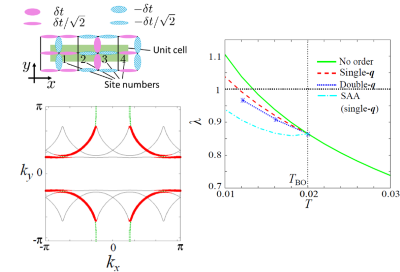Development of spin fluctuations under the presence of d-wave bond order
S. Ando, Y. Yamakawa, S. Onari, and H. Kontani, J. Phys. Soc. Jpn. 90, 063704 (2021).
In cuprate superconductors, superconductivity appears below the CDW transition temperature TCDW. However, many-body electronic states under the CDW order are still far from understood. Here, we study the development of the spin fluctuations under the presence of d-wave bond order (BO) with wavevector q = (π/2, 0), (0, π/2), which is derived from the paramagnon interference mechanism in recent theoretical studies. Based on the 4 × 1 and 4 × 4 cluster Hubbard models, the feedback effects between spin susceptibility and self-energy are calculated self-consistently by using the fluctuation-exchange (FLEX) approximation. It is found that the d-wave BO leads to a sizable suppression of the nuclear magnetic relaxation rate 1/T1. In contrast, the reduction in Tc is small, since the static susceptibility χs(Qs) is affected by the BO just slightly. It is verified that the d-wave BO scenario is consistent with the experimental electronic properties below TCDW.
(Click figure for a larger image.)

